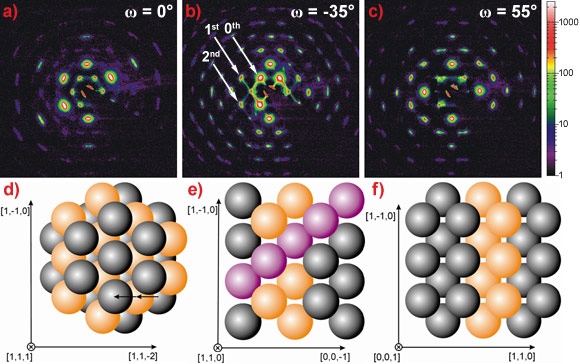- Home
- News
- Spotlight on Science
- Stacking faults...
Stacking faults in colloidal photonic crystals revealed by microradian X-ray diffraction
23-11-2009
The presence of a network of intersecting stacking faults in self-assembled colloidal crystals was demonstrated with X-ray diffraction with microradian resolution. These defects can seriously affect the optical properties of photonic materials fabricated using colloid self-assembly.
Share
Photonic crystals are materials with a periodically varying refractive index in three dimensions. If the refractive index contrast is high enough and the right crystal structure is used, light of a specific wavelength may be excluded from propagation through the crystal in any direction; just like an electron cannot propagate through a semiconductor if its energy is within the band gap. High-quality photonic crystals are highly desired since they can be used in future solar cells, LED’s, lasers and even as the basis for circuits in optical computing and optical communications.
Self-assembly of colloidal particles is a promising method for creating photonic crystals in a cheap and fast way. Unfortunately, incorporation of defects is still a major problem for applications, as these defects affect the optical properties and may close the band gap or introduce unwanted propagation channels. Therefore, detailed knowledge of defect structures and defect growth is required before application of these materials can be realised.
Studying the internal structure of photonic crystals is inherently difficult: their optical properties exclude the use of microscopy or light scattering techniques for detailed characterisation. A similar argument holds for electron microscopy techniques. These techniques yield only information about the surface structure of the crystals. X-rays do have the required penetration depth to study the interior of these crystals. However, the enormous difference between the wavelength (about one angstrom) and the structure period (particles are 425 nm in diameter) requires an extremely high resolution in reciprocal space. Using a specialised microradian X-ray diffraction setup [1] at beamline BM26 (DUBBLE), a team of researchers from Russia, France and The Netherlands have probed the internal structure of self-assembled crystals of polystyrene spheres and inverted structures fabricated using these crystals as a template. The high resolution of the setup is achieved by focusing the beam at the detector using a set of compound refractive lenses positioned next to the sample [1,2]. By rotating the samples, information about ordering in different crystallographic directions can be obtained.
It has always been assumed that crystals grown with the so-called convective assembly technique [3] have a well defined face-centred cubic (fcc) crystal structure with hexagonal close-packed planes parallel to the substrate. This configuration is shown in Figure 1a, where the X-ray beam was perpendicular to the substrate (Figure 1d for the real space configuration). The high fraction of fcc configurations in the studied samples is indeed confirmed by Figure 1c, where the incident beam is at a 55° angle with the substrate and reveals the 4-fold symmetry of the fcc structure seen along the [100] direction (real space in Figure 1f). The surprise is to be found in Figure 1b, measured along the [110] crystallographic direction of fcc. Most peaks do indeed correspond to fcc, but in addition there are diffuse scattering stripes in the images, highlighted by the arrows. These are the so-called Bragg rods and are indicative of stacking disorder. Moreover, the stacking faults are now found in different <111> directions and not only along the substrate normal as it was thought before. These findings showed that the line defects, which are usually seen at the crystal surface with scanning electron microscopy (see Figure 2), in fact correspond to two-dimensional stacking fault defects terminating at the crystal surface.
Fitting the scattering intensity profile along the Bragg rods by a modification of Wilson’s theory for X-ray diffraction [4] showed that the overall structure of the crystals can be seen as consisting of many perfect fcc ‘grains’ with the same orientation, separated by a network of stacking faults usually consisting of two planes with hexagonal close-packed (hcp) configuration. The fit results also revealed that the stacking faults make up 5-10% of the crystal structure and can therefore not be neglected in future applications of self-assembled colloidal photonic crystals.
References
[1] J.H.J. Thijssen, A.V. Petukhov, D.C. ’t Hart, A. Imhof, C.H.M. Van der Werf, R.E.I. Schropp, A. Van Blaaderen, Adv. Mater. 18, 1662 (2006).
[2] A. Snigirev, V. Kohn, I. Snigireva, B. Lengeler, Nature (London) 384, 49 (1996).
[3] P. Jiang, J.F. Bertone, K.S. Hwang, V.L. Colvin, Chem. Mater. 11, 2132 (1999).
[4] A.J.C. Wilson, Proc. R. Soc. London Ser. A 180, 277 (1941).
Principal publication and authors
J. Hilhorst (a), V.V. Abramova (b), A. Sinitskii (b,*), N.A. Sapoletova (b), K.S. Napolskii (b), A.A. Eliseev (b), D.V. Byelov (a), N.A. Grigoryeva (c), A.V. Vasilieva (d), W.G. Bouwman (e), K. Kvashnina (f,g), A. Snigirev (g), S.V. Grigoriev (d), and A.V. Petukhov (a), Double Stacking Faults in Convectively Assembled Crystals of Colloidal Spheres, Langmuir 25, 10408 (2009).
(a) Van ‘t Hoff Laboratory, Debye Institute for Nanomaterials Science, Utrecht University (The Netherlands)
(b) Department of Materials Science, Lomonosov Moscow State University (Russia)
(c) Faculty of Physics, Saint-Petersburg State University (Russia)
(d) Petersburg Nuclear Physics Institute, Gatchina (Russia)
(e) Department RRR, Faculty of Applied Sciences, TU-Delft (The Netherlands)
(f) DUBBLE, Netherlands Organization for Scientific Research (NWO), BM26, ESRF
(g) ESRF
(*) Present address: Department of Chemistry, Rice University, Houston, Texas (USA)
Top image: Microradian X-ray diffractogram (inset) of a faulted face-centred cubic colloidal photonic crystal.





